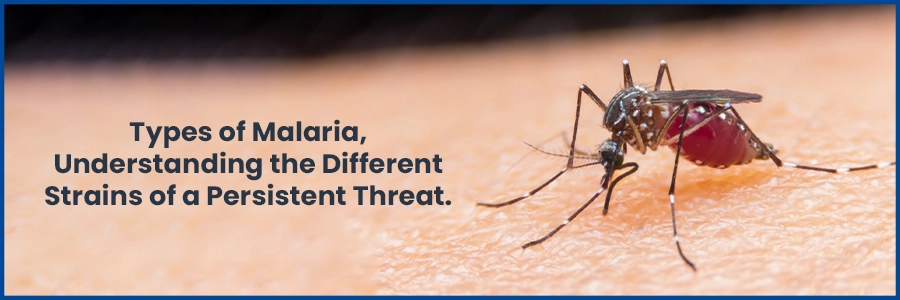Types of Malaria

Countless individuals globally, particularly in tropical and subtropical areas, are affected, by malaria - a life-threatening mosquito-borne disease. It is caused by the Plasmodium parasite and can manifest in various forms, known as types of malaria. Understanding these different strains is crucial for effective diagnosis, treatment, and prevention. Throughout this blog, we will deliver the various types of malaria and their distinctive features.
- Plasmodium falciparumPlasmodium falciparum is the most dangerous and prevalent type of malaria. It is responsible for the majority of malaria-related deaths globally. This strain exhibits rapid replication in red blood cells, leading to severe symptoms such as high fever, anemia, and organ failure. Timely diagnosis and treatment are crucial to prevent severe complications.
- Plasmodium vivaxPlasmodium vivax is the second most common type of malaria and is widely distributed across various regions. It's capacity to lie dormant in the liver and reactivate in the bloodstream results in recurrent fever episodes. Although usually not as severe as P. falciparum, P. vivax can cause substantial discomfort and contribute to anemia and other health complications.
- Plasmodium ovalePlasmodium ovale is less common but similar to P. vivax in its ability to produce relapses. It also remains in the liver, leading to recurrent malaria episodes. While not as severe as P. falciparum, P. ovale requires medical attention for proper management.
- Plasmodium malariaePlasmodium malariae is known for its slow replication rate, causing milder but persistent symptoms. Unlike other strains, P. malariae can remain in the body for several years, causing chronic infection. It can contribute to kidney damage if left untreated.
- Plasmodium knowlesiPlasmodium knowlesi is primarily found in Southeast Asia and is transmitted from monkeys to humans through mosquito bites. It can lead to severe malaria, resembling P. falciparum infections.
Conclusion
Recognizing the different types of malaria is crucial for healthcare professionals in providing appropriate treatment and care. Timely detection, immediate medical care, and preventive actions like mosquito control and bed net usage are vital in reducing malaria-related illnesses and fatalities. Global efforts continue to focus on eradicating malaria through comprehensive strategies, improved healthcare infrastructure, and enhanced research into vaccines and treatments. As we work together, we can curb the impact of this persistent threat and bring us closer to a malaria-free world.Remember, if you are planning to travel to malaria-endemic regions or experience symptoms like fever and chills after returning from such areas, seek immediate medical attention to rule out malaria infection. Prevention, vigilance, and early intervention are our best defenses against this ancient yet formidable disease. Stay informed, stay protected!